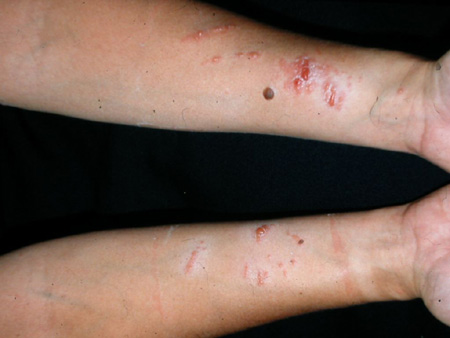Aetiology
Irritant contact dermatitis (ICD) is the most common form of contact dermatitis and is due to direct, cytotoxic barrier damage. Common causes of ICD include chronic exposure to mild irritants (water, soaps, solvents, cutting fluids) or from acute exposure to more toxic agents (acids, alkalis, strong oxidising or reducing agents, organic solvents, and gasses). Chronic cumulative ICD is the most common form of ICD (e.g., frequent hand washing or lip licking).[9][13]
In 2019-2020, the most common positive patch tests recorded by the North American Contact Dermatitis Group (NACDG) were to the following allergens: nickel (18.2%), methylisothiazolinone (13.8%), fragrance mix I (12.8%), hydroperoxides of linalool (11.1%), and benzisothiazolinone (10.4%). Compared with 2017-2018, the prevalence of top 20 allergens statistically increased for fragrance mix I, benzisothiazolinone, propolis, and hydroperoxides of limonene (3.5%).[14]
However, positive patch test reactions are not always relevant and determination of clinical relevance is of tantamount importance (e.g., did the positive allergen cause the rash?). While nickel is the top contact allergen around the world, other allergens such as Toxicodendron species (poison ivy, poison sumac) are far more common causes of allergic contact dermatitis, but are not tested with standard patch tests because diagnosis can often be made on clinical grounds alone.
[Figure caption and citation for the preceding image starts]: Allergic contact dermatitis to Toxicodendron species From the personal collection of Dr Snehal Desai [Citation ends].
The most common allergens in children differ slightly due to differing exposures. The most common allergens in children reported by the NACDG including data from 2001-2018 were: nickel sulfate (17.3%), hydroperoxides of linalool (7.8%), methylisothiazolinone (7.7%), cobalt chloride (7.0%), and fragrance mix I (4.9%).[6]
The most common causes of photoallergic contact dermatitis are sunscreens (23.2%), antimicrobial agents (23.2% with mainly fentichlor), medications (20.3%), fragrances (13%), plants and plant derivatives (11.6%), and pesticides (8.7%).[15]
Pathophysiology
Allergic contact dermatitis (ACD) requires prior sensitisation to occur. Most allergens are haptens, small hydrophobic molecules that must bind to proteins to become antigenic. The hapten-protein complex enters the stratum corneum and binds to epidermal antigen-presenting Langerhans cells. These cells process the antigen and travel to regional lymph nodes where they present the antigen to naive CD4 T cells. These T cells then proliferate into memory and effector T cells, which elicit ACD within 48 to 96 hours of re-exposure to the allergen.[16] Mimicking topical exposure to a hapten, an allergic dermatitis reaction may develop after systemic exposure to a drug through haematogenous transport.[17]
Irritant contact dermatitis (ICD) results from exposure to an agent that causes direct skin toxicity. No prior sensitisation is required; ICD can occur in anyone if the concentration and duration of exposure are sufficient. The spectrum of ICD ranges from acute disease, caused by a single exposure to a severe irritant, to chronic disease caused by repeated exposure to a mild irritant. The concentration of the irritant and duration of exposure determine the severity of disease with acute exposures. Repeated exposure from a mild irritant leads to disruption of the epidermal barrier and increased transepidermal water loss.[9][13]
Classification
Types of contact dermatitis
Irritant contact dermatitis is caused by direct toxicity and can occur in any person without prior sensitisation.
Allergic contact dermatitis is a delayed hypersensitivity reaction, which requires prior sensitisation.
Use of this content is subject to our disclaimer